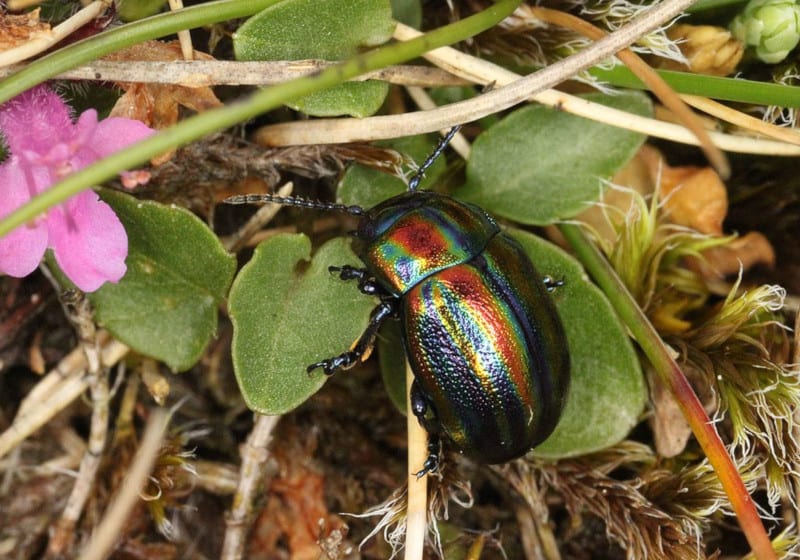
Photographer: Janet Graham
CC License: https://bit.ly/2sQieMu
Rainbow Leaf Beetle Facts
- Firstly, the term Rainbow Leaf Beetles serves as the common name for the gorgeous Chrysolina cerealis. But, this stunning invertebrate also goes by another common name. That holds true because it also goes by the name of the Snowdon Beetle. Whatever name one calls it by, it ranks as one of the most dazzling insects of its type in the world.
- However, this remarkable insect also finds itself in a situation similar to an increasing number of other species in the world. That’s because, while it inhabits a rather broad range, and in moderately large numbers, it finds itself threatened in certain individual regions of its endemic range. This terrible situation also continues to deteriorate.
- Therefore, though the IUCN does not presently have a listing for it, the local population in the United Kingdom now lists as Endangered. Further, the dangers it faces vary from region to region, as well as relative threat levels. But, one severe, and increasing, danger it faces in all parts of its range remains the global threat of climate change.
Related Articles
Scarab Beetle Christmas Beetle Goliath Beetle
Photographer: Janet Graham
CC License: https://bit.ly/1ryPA8o
Rainbow Leaf Beetle Physical Description
Most notably, regardless of its extremely beautiful appearance, the Rainbow Leaf Beetle nevertheless remains a physically small variety of insect. Like many related creatures, it also displays a moderate degree of the principle of sexual dimorphism.
Furthermore, in its case, this occurs in the matter of sheer physical size. As a result, the females generally attain an overall body length of about 0.39 in (10 mm). Meanwhile, the significantly smaller males only reach an average length of around 0.22 in (5.5 mm).
However, its most remarkable characteristic, and the one that inspired its common name, remains its brilliant color scheme. While the exact pattern of coloring varies, the same colors predominate. These stunning colors include metallic blue, green, and red, with the presence of several longitudinal stripes as well.
- Kingdom: Animalia
- Phylum:Arthropoda
- Class: Insecta
- Order: Coleoptera
- Family: Chrysomelidae
- Genus: Chrysolina
- Species: C. cerealis
Photographer: Doug88888
CC License: https://bit.ly/1iowB8m
Rainbow Leaf Beetle Distribution, Habitat, and Ecology
The truly magnificent variety of Eurasian leaf beetle known as the Rainbow Leaf Beetle evolved as native to a specific region. But, that specific range also qualifies as somewhat large. It inhabits areas from Norway to northern Italy, from Ussuri in the east, and also Wales in the west.
It does have one factor going for it, though, in regards to its survival. That’s the fact that it possesses a high degree of adaptability in regards to its habitat. That’s because the insect inhabits areas of woodlands, forests, wastelands, meadows, and montane grasslands. This includes altitudes of up to as much as 1,968 ft (600 m).
It most commonly appears between the months of April and September, throughout its endemic range. It also lives in a harsh habitat, usually consisting of rocky areas known as scree. Both the larvae and the adult feed on several types of plants, generally preferring the flowers over the foliage.
Species Sharing Its Range
Scottish Wildcat Plumed midge-orchid Shrill Carder Bee
Check out our articles on Distinctive North American Woody Shrubs, Christmas Cheer, Kali Gandaki Gorge, Thorny Dragon, Red Veined Darter, Scythian Lamb, Purple Frog

